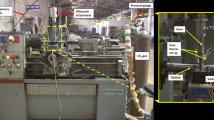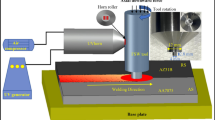Abstract
GH4169 nickel-based high-temperature alloy demonstrates excellent mechanical, chemical, thermal shock, and mechanical load resistance properties. However, it is typically a difficult-to-machine material. Ultrasonic vibration–assisted milling can effectively solve the machining challenges of GH4169 nickel-based high-temperature alloy and improve surface integrity. Herein, the motion model of the tool-tip under ultrasonic vibration assistance is established. The tool-tip motion trajectory and chip separation law are analyzed. The effect of ultrasonic vibration on surface integrity is investigated through ultrasonic vibration–assisted milling experiments. The results show that residual surface stress stimulates at high milling speed, depth of cut, and feed rate, while it progressively decreases with ultrasonic amplitude. The machined surface hardening enhances with the addition of ultrasonic amplitude. The machined surface roughness increases with the growth of milling speed, feed rate, and ultrasonic amplitude, and decreases with the rise of cutting surface roughness increases with the addition of milling speed, feed rate, and ultrasonic amplitude, and falls with the rise of cutting depth.










Similar content being viewed by others
Data availability
The datasets used or analyzed during the current study are available from the corresponding author on reasonable request.
References
Li S, Xiao G, Chen B, Zhuo X, Xu J, Huang Y (2022) Surface formation modeling and surface integrity research of normal ultrasonic assisted flexible abrasive belt grinding. J Manuf Process 80:232–246. https://doi.org/10.1016/j.jmapro.2022.05.045
Wang Y, Pang S, Yan P, Jiao L, Qiu T, Zhou H, Wang X (2022) Experimental research on cryogenic cutting performance of Ni-based superalloy GH4169. Int J Adv Manuf Technol 121:379–392. https://doi.org/10.1007/s00170-022-09325-7
Zhang X, Yang L, Wang Y, Lin B, Dong Y, Shi C (2020) Mechanism study on ultrasonic vibration assisted face grinding of Hard and brittle materials. J Manuf Process 50:520–527. https://doi.org/10.1016/j.jmapro.2020.01.003
Xiao G, Chen B, Li S, Zhuo X, Zhao Z (2022) Surface integrity and fatigue performance of GH4169 superalloy using abrasive belt grinding. Eng Fail Anal 142:106764. https://doi.org/10.1016/j.engfailanal.2022.106764
Yuan SM, Yan LT, Liu WD, Liu Q (2010) Investigation of machinability in minimum quantity lubrication milling of GH4169 aerospace superalloy. AMM 34–35:666–670. https://doi.org/10.4028/www.scientific.net/AMM.34-35.666
Zhao C, Wang ZB, Wang XH, Xi W, Shi YY (2014) Research on cutting vibration in high-speed milling nickel-base superalloy. MSF 800–801:793–797. https://doi.org/10.4028/www.scientific.net/MSF.800-801.793
Wang H, Zhou F, Han RD (2012) Research on cutting force and surface roughness in face milling Ni-based superalloy. AMR 588–589:1698–1701. https://doi.org/10.4028/www.scientific.net/AMR.588-589.1698
Liu WW, Wan XS, Li XY, Yu Y, Wang DF (2013) A study of the sensitivity of parameters affecting surface roughness in high speed milling superalloy GH4169. AMR 711:143–148. https://doi.org/10.4028/www.scientific.net/AMR.711.143
Akhtar W, Sun J, Chen W (2016) Effect of machining parameters on surface integrity in high speed milling of super alloy GH4169/Inconel 718. Mater Manuf Processes 31:620–627. https://doi.org/10.1080/10426914.2014.994769
Li X, Ma S, Meng F (2015) Surface integrity of GH4169 affected by cantilever finish grinding and the application in aero-engine blades. Chin J Aeronaut 28:1539–1545. https://doi.org/10.1016/j.cja.2015.06.023
Wang H, Lu Y, Liu JJ (2015) Study on tool wear in green milling Ni-based superalloy. AMR 1095:865–868. https://doi.org/10.4028/www.scientific.net/AMR.1095.865
Li X, Guan C, Zhao P (2018) Influences of milling and grinding on machined surface roughness and fatigue behavior of GH4169 superalloy workpieces. Chin J Aeronaut 31:1399–1405. https://doi.org/10.1016/j.cja.2017.07.013
Xu R, Zhou Y, Li X, Yang S, Han K, Wang S (2019) The effect of milling cooling conditions on the surface integrity and fatigue behavior of the GH4169 superalloy. Metals 9:1179. https://doi.org/10.3390/met9111179
Miao Q, Ding W, Kuang W, Yang C (2020) Comparison on grindability and surface integrity in creep feed grinding of GH4169, K403, DZ408 and DD6 nickel-based superalloys. J Manuf Process 49:175–186. https://doi.org/10.1016/j.jmapro.2019.11.027
Quan F, Chen Z, Li Q, Gao S (2020) Effects of process combinations of milling, grinding, and polishing on the surface integrity and fatigue life of GH4169 components. Proc Inst Mech Eng Part B-J Eng Manuf 234:538–548. https://doi.org/10.1177/0954405419868053
Zhu P, Liu Z, Ren X, Wang B, Song Q (2021) Effects of sequential operation with heat treatment and mechanical milling on work hardening for superalloy GH4169. Metals 11:1367. https://doi.org/10.3390/met11091367
Yao G, Liu Z, Song Q, Wang B, Cai Y (2022) Numerical prediction and experimental investigation of residual stresses in sequential milling of GH4169 considering initial stress effect. Int J Adv Manuf Technol 119:7215–7228. https://doi.org/10.1007/s00170-022-08740-0
Chang B, Yi Z, Cao X, Duan J (2023) Defect suppression and grain refinement during ultrasonic vibration-assisted side milling of GH4169 superalloy. J Manuf Process 85:281–294. https://doi.org/10.1016/j.jmapro.2022.11.011
Lotfi M, Amini S, Aghayar Z, Sajjady SA, Farid AA (2020) Effect of 3D elliptical ultrasonic assisted boring on surface integrity. Measurement 163:108008. https://doi.org/10.1016/j.measurement.2020.108008
Wang F, Men X, Liu Y, Fu X (2020) Experiment and simulation study on influence of ultrasonic rolling parameters on residual stress of Ti-6Al-4V alloy. Simul Model Pract Theory 104:102121. https://doi.org/10.1016/j.simpat.2020.102121
Chen Y, Su H, He J, Qian N, Gu J, Xu J, Ding K (2021) The effect of torsional vibration in longitudinal–torsional coupled ultrasonic vibration-assisted grinding of silicon carbide ceramics. Materials 14:688. https://doi.org/10.3390/ma14030688
Yang Z, Zhu L, Ni C, Ning J (2019) Investigation of surface topography formation mechanism based on abrasive-workpiece contact rate model in tangential ultrasonic vibration-assisted CBN grinding of ZrO2 ceramics. Int J Mech Sci 155:66–82. https://doi.org/10.1016/j.ijmecsci.2019.02.031
Shen JY, Wang JQ, Jiang B, Xu XP (2015) Study on wear of diamond wheel in ultrasonic vibration-assisted grinding ceramic. Wear 332–333:788–793. https://doi.org/10.1016/j.wear.2015.02.047
Choi Y-J, Park K-H, Hong Y-H, Kim K-T, Lee S-W, Choi H-Z (2013) Effect of ultrasonic vibration in grinding; horn design and experiment. Int J Precis Eng Manuf 14:1873–1879. https://doi.org/10.1007/s12541-013-0253-1
Deswal N, Kant R (2023) Hybrid turning process by interacting ultrasonic vibration and laser energies. Mater Manuf Processes 38:570–576. https://doi.org/10.1080/10426914.2022.2065014
Airao J, Nirala CK, Bertolini R, Krolczyk GM, Khanna N (2022) Sustainable cooling strategies to reduce tool wear, power consumption and surface roughness during ultrasonic assisted turning of Ti-6Al-4V. Tribol Int 169:107494. https://doi.org/10.1016/j.triboint.2022.107494
Arka GN, Sahoo SK, Iqbal MM, Singh S (2022) Acoustic horn tool assembly design for ultrasonic assisted turning and its effects on performance potential. Mater Manuf Processes 37:260–270. https://doi.org/10.1080/10426914.2021.2016819
Bayat M, Amini S, Hadidi M (2021) Effect of ultrasonic-assisted turning on geometrical tolerances in Al 2024–T6. Mater Manuf Processes 36:1875–1886. https://doi.org/10.1080/10426914.2021.1926496
Zamani M, Farahnakian M, Elhami S (2021) Employment of ultrasonic assisted turning in the fabrication of microtextures to improve the surface adhesion of the titanium implant. Proc Inst Mech Eng, Part B: J Eng Manuf 235:1983–1991. https://doi.org/10.1177/09544054211011029
Zhang J, Du J, Li B, Su G (2023) Investigation on white layer formation in dry high-speed milling of nickel-based superalloy GH4169. Machines 11:406. https://doi.org/10.3390/machines11030406
Xun L, Shuang M, Fanjun M (2015) Surface integrity of GH4169 affected by cantilever finish grinding and the application in aero-engine blades. Chin J Aeronaut 28:1539–1545. https://doi.org/10.1016/j.cja.2015.06.023
Zeng Q, Liu G, Liu L, Qin Y (2015) Investigation into grindability of a superalloy and effects of grinding parameters on its surface integrity. Proc Inst Mech Eng Part B-J Eng Manuf 229:238–250. https://doi.org/10.1177/0954405414526384
Li W, Chen Q, Wu J, Liu M, Ren Y, Ibrahim AMM (2022) Investigation of the effect of vibration characteristics on the grinding performance of aero-engine blade tip. Int J Adv Manuf Technol 120:4663–4679. https://doi.org/10.1007/s00170-022-09045-y
Akhtar W, Sun J, Chen W (2016) Effect of machining parameters on surface integrity in high speed milling of super alloy GH4169/Inconel 718. Mater Manuf Process 31:620–627. https://doi.org/10.1080/10426914.2014.994769
Wu M, Yu Y, Cheng Y, Li L, Zhao X (2018) Experimental investigation of chip plastic side flow in machining of GH4169 superalloy under high-pressure cooling. Ferroelectrics 530:82–96. https://doi.org/10.1080/00150193.2018.1453123
Hansen N (2004) Hall-Petch relation and boundary strengthening. Scripta Mater 51:801–806. https://doi.org/10.1016/j.scriptamat.2004.06.002
Funding
This work was financially supported by the National Natural Science Foundation of China (52075439); the Doctoral Dissertation Innovation Fund of Xi’an University of Technology (252072203).
Author information
Authors and Affiliations
Contributions
Jian Sun, Pengyang Li and Yunshuai Chen developed the idea of the study and contributed to the acquisition and interpretation of data; Shen Zhang and Han Lu participated in design and coordination, and they helped to draft the manuscript; Guoqing Chena and Ding Shao provided critical review and substantially revised the manuscript. All authors read and approved the final manuscript.
Corresponding author
Ethics declarations
Conflict of interest
The authors declare no competing interests.
Additional information
Publisher's Note
Springer Nature remains neutral with regard to jurisdictional claims in published maps and institutional affiliations.
Rights and permissions
Springer Nature or its licensor (e.g. a society or other partner) holds exclusive rights to this article under a publishing agreement with the author(s) or other rightsholder(s); author self-archiving of the accepted manuscript version of this article is solely governed by the terms of such publishing agreement and applicable law.
About this article
Cite this article
Sun, J., Li, P., Zhang, S. et al. Experimental study of surface integrity in ultrasonic vibration–assisted milling of GH4169 nickel-based superalloy. Int J Adv Manuf Technol 129, 5047–5058 (2023). https://doi.org/10.1007/s00170-023-12578-5
Received:
Accepted:
Published:
Issue Date:
DOI: https://doi.org/10.1007/s00170-023-12578-5




